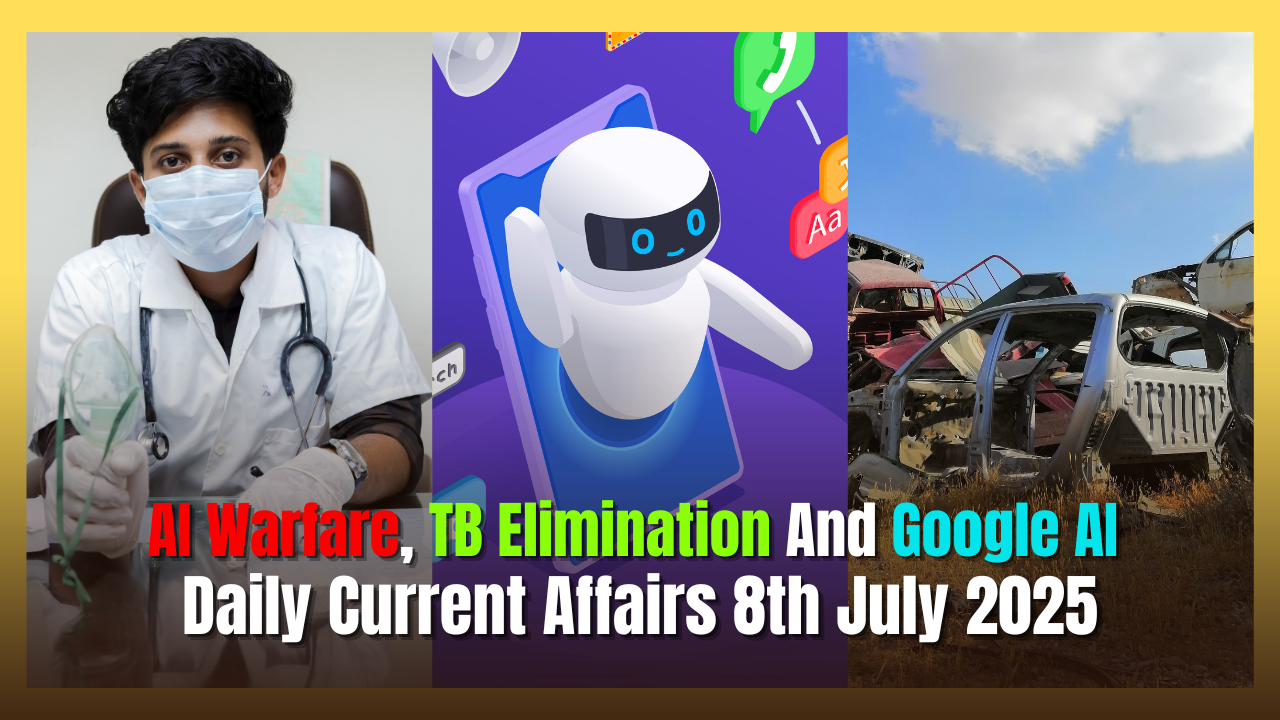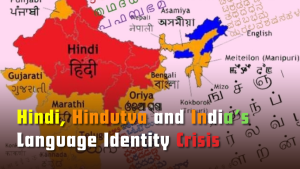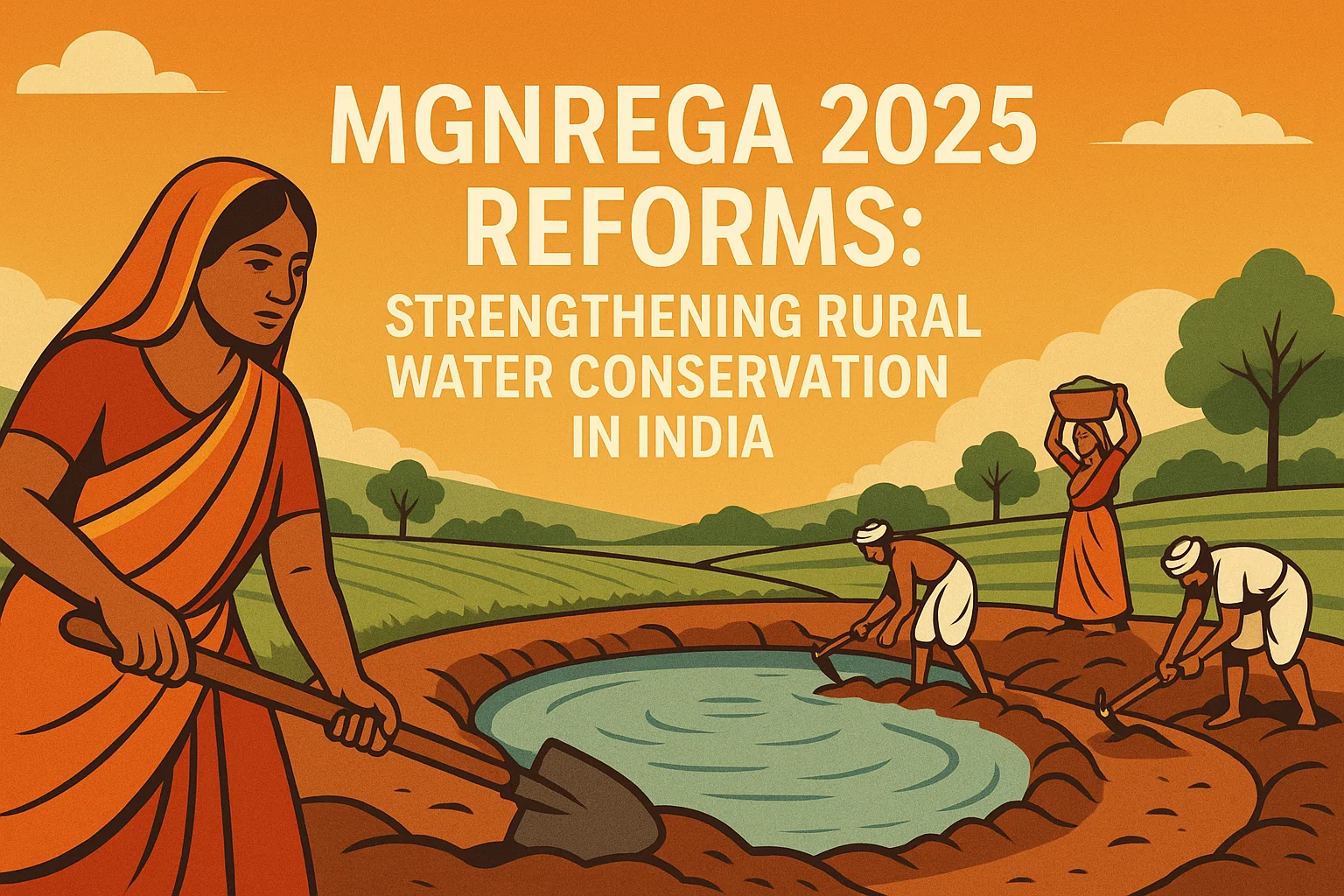Daily Current Affairs 08th July 2025
Today’s current affairs roundup brings together critical updates from the fields of environment, economy, defence, health, technology, and communication. From policy changes in Delhi to the rising role of AI in both war and search engines, here are the key topics we’re covering:
1) Delhi’s Ban on Fuel for Old Vehicles
2) Why Is India’s Household Savings Rate Declining?
3) Revolutionising Warfare Through AI
4) Ham Radio
5) India’s TB Elimination Drive
6) Google’s AI Overviews
Delhi’s Ban on Fuel for Old Vehicles
Context: As of July 1, 2025, petrol stations across Delhi have begun denying fuel to diesel vehicles older than 10 years and petrol vehicles older than 15 years, in line with long-standing environmental mandates.
More on News
- The directive was issued by the Commission for Air Quality Management (CAQM) as a decisive measure to remove end-of-life vehicles (ELVs) from roads and combat worsening air pollution in Delhi-NCR.
- The move follows earlier court rulings and is part of broader efforts to curb emissions from vehicular sources, which are major contributors to PM2.5, NOx, and SO2 levels in the National Capital Region.
How Does the Enforcement Mechanism Work?
- To enforce the fuel ban, Automatic Number Plate Recognition (ANPR) cameras have been installed at 498 fuel stations and three ISBTs across Delhi.
- These cameras scan vehicle number plates and match them with the VAHAN database, India’s national vehicle registry.
- When an ELV is detected: An audio alert is triggered, the vehicle is denied fuel.
- It may be impounded and scrapped if proper exemptions are not presented.
- Enforcement is managed by a joint team comprising the Delhi Transport Department, Traffic Police, and municipal officials.
Why Is the Delhi Government Hesitating on Full Implementation?
- Despite the ban’s legal foundation, Delhi Environment Minister has urged the CAQM to pause implementation, citing: Technical glitches in ANPR systems, Non-functional speakers and sensors, Difficulty identifying vehicles without high-security registration plates (HSRPs), Lack of integration with NCR state databases, leading to fuel circumvention from nearby districts and Rising public dissatisfaction and confusion.
- This has led to poor enforcement numbers — from 80 vehicles seized on July 1 to zero by July 4.
How Many Vehicles Are Affected by the Fuel Ban?
- Delhi alone has 62 lakh ELVs, including 41 lakh two-wheelers and 18 lakh four-wheelers
- Haryana NCR has 27.5 lakh ELVs
- Uttar Pradesh NCR accounts for 12.4 lakh
- Rajasthan NCR has 6.1 lakh ELVs
- The scale of the ban, therefore, is massive and unprecedented, targeting a significant portion of Delhi’s vehicular fleet.
Why Are Older Vehicles Being Targeted?
- Authorities argue that older vehicles, particularly those pre-dating the BS-VI emission norms, emit disproportionately higher levels of pollutants:
-
- BS-IV vehicles emit up to 5.5 times more PM than BS-VI vehicles.
-
- Transport emissions contribute 28% of PM2.5, 41% of SO₂, and 78% of NOx in Delhi.
- Though some old vehicles may be well-maintained, aggregate emissions data support age-based regulations as a practical mitigation tool.
What Is the Legal Framework Behind This Ban?
- 2015 NGT Order: Banned diesel vehicles over 10 years and petrol vehicles over 15 years in Delhi-NCR
- 2018 Supreme Court ruling: Upheld the NGT directive and mandated impounding of violators
- Motor Vehicles Act, 1988: Validity of RCs capped at 15 years for private vehicles
- Environment Protection (End-of-Life Vehicles) Rules, 2025: Made scrapping mandatory within 180 days post-registration expiry
Can This Policy Alone Solve Delhi’s Air Pollution Crisis?
Experts and think tanks like the Centre for Science and Environment (CSE) argue:
- Age cap alone is insufficient
- Pollution levels also depend on maintenance and fuel quality
- Need for strengthened PUC (Pollution Under Control) systems
- Investment in public transport infrastructure is critical
- Pan-India implementation is unfeasible without uniform enforcement capacity
Why Is India’s Household Savings Rate Declining?
Concern over falling household savings in India
Context: India, traditionally a high-saving economy driven by security-conscious households, has witnessed a steady decline in its gross domestic savings rate — from 34.6% of GDP in 2011–12 to 29.7% in 2022–23, marking the lowest level in four decades.
More on News
- This decline is attributed to rising consumption, high inflation, and the increased financialisation of savings.
- Historically, household savings made up around 60% of total domestic savings, largely concentrated in physical assets such as gold and real estate, influenced by cultural preferences and limited access to financial instruments.
What Structural Shifts Are Affecting Household Savings in India?
- Household financial savings as a share of GDP declined sharply from 11.5% in FY21 to 5.1% in FY23 (RBI).
- Household liabilities surged due to increased borrowing for consumption, housing, and education, hitting a 17-year high of 6.4% of GDP in FY24.
- There’s a rising tilt towards equities and mutual funds, supported by digitisation and financial inclusion.
- For instance, SIP contributions jumped 8.5 times from ₹3,122 crore in April 2016 to ₹26,632 crore in April 2025.
- Although Covid-19 lockdowns briefly increased savings, normal consumption patterns quickly resumed, reversing the trend.
- However, FY25 has shown signs of recovery.
- In H1 FY25, net household financial savings rose to 7.3% of GDP, while liabilities declined to 4.7% — a trend partly shaped by the RBI’s tightened lending norms on personal, gold, and NBFC loans to ensure financial stability.
How Has the Asset Mix of Indian Households Evolved?
- The share of financial savings in total savings dropped from 40.3% in FY20 to 28.5% in FY24.
- Physical assets now constitute 71.5% of household savings, up from 59.7% in FY20.
- Deposits, once accounting for 58% of savings in FY12, declined to 37% in FY23.
- Conversely, provident and pension fund savings rose from 10% in FY12 to 23% in FY24, reflecting growing trust in retirement-oriented instruments.
- Urban households continue to lead this transition due to better financial literacy and access to banking, while rural households lag due to structural limitations.
What Are the Rural-Urban Gaps in Financial Savings?
-
- Between FY21 and FY23, household investments in mutual funds and equities nearly doubled from ₹1.02 trillion to ₹2.02 trillion.
- While this reflects growing wealth, it also raises concerns about financial vulnerability, especially among low-income households.
-
To address these disparities, India must:
-
- Develop customised micro-savings products for rural and informal segments.
- Provide government-backed guarantees and tax benefits to incentivise small savers.
- Revamp traditional schemes like Kisan Vikas Patra and Public Provident Fund to make them more attractive.
What Policy Reforms Can Revive and Restructure Household Savings?
- Simplifying capital gains and tax structures related to savings and investments to encourage broader participation.
- Expanding the National Pension Scheme (NPS) through auto-enrolment of informal workers and incentivising employer contributions.
- Strengthening regulatory oversight on mutual funds, insurance, and digital lending to protect small investors.
- Creating a national household savings strategy, with inter-ministerial coordination and clear targets.
How Can Technology and Behavioural Nudges Promote Savings?
-
- Fintech platforms now offer user-friendly saving tools, AI-driven financial advice, and micro-investing options tailored to small savers.
- Blockchain and smart contracts can enhance transparency and reduce inefficiencies in traditional savings mechanisms like recurring deposits and P2P lending.
-
Behavioural economics also offers solutions:
-
- Default enrollment in pension schemes (opt-out models) significantly increases participation.
- Nudging savers through gamified apps, periodic reminders, and reward-based savings products can foster long-term habits.
Revolutionising Warfare Through AI
Context: Long before its breakthrough DeepSeek AI model gained global attention, China’s People’s Liberation Army (PLA) had already embarked on a path of “intelligentised warfare” — the PLA’s term for integrating artificial intelligence (AI) across all major domains of military operations.
Why Should India Be Concerned About the China-Pakistan AI Nexus?
- China is actively supporting Pakistan’s military AI programmes, particularly through the Centre of Artificial Intelligence and Computing (CAIC) established by the Pakistan Air Force in 2020.
- This centre hosts advanced Cognitive Electronic Warfare (CEW) programmes aimed at improving tactical and analytical decision-making using AI.
- During Operation Sindoor, Indian officials observed signs of China-enabled real-time satellite feeds being relayed to Pakistan, with AI-based vector targeting likely powered by backend Chinese computing systems.
- Pakistan’s ability to prime vectors in real-time indicates the use of C4ISR capabilities — Command, Control, Communications, Computers, Intelligence, Surveillance, and Reconnaissance — with Chinese support.
What Makes AI a Force Multiplier in Modern Warfare?
- In modern warfare, multi-domain operations (MDO) — integrating land, air, sea, space, and cyberspace — require armed forces to handle massive data volumes.
- AI allows militaries to detect enemy movements faster, predict threats through machine learning and automate tactical decisions with minimal human delay.
- This rapid decision-making capability is foundational to the emerging concept of “agentic warfare”, where autonomous AI systems or agents outperform traditional forces.
Why Is Energy the Hidden Backbone of AI-Driven Defence?
- AI technologies such as Big Data analytics, natural language processing, and predictive analysis consume vast amounts of electricity.
- India is currently underpowered in this respect, with only 7.5 GW of installed nuclear capacity, compared to South Korea’s 24 GW, despite being far larger.
- There is a need for Small Modular Reactors (SMRs) to be built adjacent to AI data centres, enabling localised, high-density power, autonomous defence systems and seamless operation of drones, robots, and smart weapons.
How Can India Overcome Its Energy and AI Infrastructure Gaps?
- India’s energy shortfalls stem from multiple structural issues:
- Over-dependence on renewables without energy storage
- Reduced thermal capacity expansion since 2015
- Inadequate nuclear investments due to regulatory and financial hurdles
- Policy planners are now reconsidering SMRs and seeking private sector involvement in nuclear and thermal generation to build resilient AI-enabled defence capabilities.
What Has India Done So Far in AI-Driven Military Development?
- India was an early adopter of AI in defence, with DRDO’s Centre for Artificial Intelligence and Robotics (CAIR) established in 1986.
- However, while progress has been made, India’s AI capabilities are being outpaced by China’s AI-export diplomacy, especially its support to Pakistan’s defence.
What Is the Global Scenario of AI in Military Conflicts?
- Ukraine has deployed AI-guided long-range drones to autonomously identify and strike targets
- Israel’s “Lavender” AI reportedly identified 37,000 Hamas targets in the Gaza conflict, making it the first major AI-powered war
- The Centre for Joint Warfare Studies in India has observed rapid advancements in autonomous weapons, cybersecurity and intelligence gathering and simulation-based military training.
Ham Radio
What is ham radio communication?
Context: Group Captain Shubhanshu Shukla, currently aboard the International Space Station (ISS) as part of the Axiom-4 (Ax-4) mission, engaged in a live interaction with students via ham radio on July 4. The 10-minute session took place at the U.R. Rao Satellite Centre (URSC) in Bengaluru, where around 70 students had gathered for the rare opportunity.
The Axiom-4 mission launched on June 25, 2025, from NASA’s Kennedy Space Center in Florida. After a 28.5-hour journey aboard the SpaceX Dragon spacecraft, Shukla and his fellow crew members successfully docked with the ISS, beginning their 14-day stay in orbit. This mission marks a significant moment for India’s growing presence in space exploration, with Gp Capt. Shukla represented the country in an international crew aboard the ISS.
What is Ham Radio?
- Ham radio, or amateur radio, is a licensed radio communication system operated by individuals for non-commercial purposes such as:
- Education and self-training
- Emergency communication during disasters
- Scientific and hobby-based experimentation
- It operates on dedicated radio frequencies using a transceiver, antenna, and radio waves.
- In India, anyone above the age of 12 can apply for a ham radio license from the Ministry of Electronics and Information Technology.
Use of Ham Radio in Space
- Ham radio was first used in space in 1983 aboard a space shuttle. Since then, it has become a regular feature on the ISS, where it is known as Amateur Radio on the International Space Station (ARISS).
- It allows astronauts to interact directly with students and enthusiasts on Earth, making science and space more accessible and inspiring.
- Supported by amateur radio organisations and space agencies from the U.S., Russia, Canada, Japan, and Europe, ARISS provides both equipment and operational support. To prevent signal interference during critical operations, ARISS suspends communications during events like docking.
Why Is Ham Radio Still Relevant?
- Despite technological advancements, radio remains a stable, reliable communication method. Ham radio is a trusted backup during emergencies, especially when conventional systems fail.
- Notable examples in India: Bhuj earthquake (2001), Indian Ocean tsunami (2004), Uttarakhand floods (2013).
India’s TB Elimination Drive
How new technology can help India close in on TB
Context: Prime Minister Narendra Modi recently reviewed the National Tuberculosis Elimination Programme (NTEP), emphasising public participation and the scaling up of innovative strategies. This comes at a crucial time, as advancements in diagnostics, digital tools, and vaccines present new opportunities to detect, treat, and prevent TB more effectively.
Why is Tuberculosis (TB) Elimination a Priority for India?
- Tuberculosis remains one of India’s gravest public health challenges. As per the WHO Global TB Report 2024, India has achieved a 17.7% reduction in TB incidence (2015–2023)—a decline that outpaces the global average of 8.3%. However, India still carries the highest global TB burden, making elimination not just a health imperative but also a developmental goal.
- India has set an ambitious target to eliminate TB by 2025, five years ahead of the UN Sustainable Development Goal (SDG) timeline of 2030. This urgency stems from:
- High case burden: Subclinical TB (asymptomatic cases) is estimated to form ~50% of India’s TB load, going undetected and fueling transmission.
- Economic impact: TB contributes to poverty cycles due to prolonged illness and loss of income.
- Global implications: India’s success could offer a template for global eradication, influencing policy and practice in high-burden regions.
What is India’s TB Elimination Framework?
- National Tuberculosis Elimination Programme (NTEP) is India’s flagship initiative for TB control and eradication.
- Vision: A TB-free India with zero deaths, disease, and poverty due to tuberculosis.
- Strategic Pillars: Detect – Treat – Prevent – Build (DTPB)
- National Strategic Plan (NSP) 2017–2025: A roadmap integrating private-sector engagement, community involvement, and technological innovation.
Recent Achievements:
- Intensified TB-Mukt Bharat Abhiyaan (100-day campaign): 7.19 lakh TB cases detected, including 2.85 lakh asymptomatic patients using portable AI-enabled chest X-rays. Represents a paradigm shift from symptom-based to tech-based screening.
- Community Partnership Models: Idukki district, Kerala, in collaboration with Kudumbashree SHGs, showed how grassroots ownership improves TB surveillance and care.
- Learning from Global Best Practices: Vietnam’s active case finding model among high-risk groups is being explored for adaptation in Indian urban slums and tribal belts.
Lessons from Global TB Resurgence (1980s-90s)
- Historically, TB had declined dramatically in Europe and the U.S. by the 1950s due to better living conditions and antibiotics. However, a dangerous reversal occurred in the 1980s–1990s, highlighting key lessons:
- HIV/AIDS Epidemic: HIV weakens the immune system, allowing latent TB to become active. In the U.S. (1993), HIV-positive individuals (0.5% of population) accounted for ~50% of TB deaths.
- Drug-Resistant TB Emergence: Misuse of antibiotics led to multi-drug-resistant TB (MDR-TB). Treatment became costlier, longer, and less effective.
- Migration from High-TB Countries: Post-1965 immigration reforms in the U.S. increased inflow from high-burden countries. TB rates in immigrants were 4x higher than in native-born citizens.
- Lesson for India: TB resurgence can happen even in developed nations, if diagnostic vigilance and public health funding wane.
How Are New Technologies Revolutionising TB Diagnosis?
- The diagnostic gap remains the weakest link in the TB care cascade. In 2023, 2.7 million TB cases worldwide went undiagnosed. India is tackling this through:
- Non-invasive sample collection: Tongue and nasal swabs, especially for children and elderly.
- AI-powered imaging: Rapid interpretation of chest X-rays with machine learning tools for rural, hard-to-reach areas.
- Open PCR platforms: Supported by ICMR, to lower costs of molecular diagnosis in public facilities.
- Digital surveillance via Nikshay portal: Tracks every case and treatment response for robust data governance.
- Nikshay Poshan Yojana (NPY) doubled monthly nutritional support (from ₹500 to ₹1,000) to help patients meet dietary needs during treatment.
What Role Will Vaccines Play in TB Elimination?
- An effective TB vaccine is crucial for ending the epidemic.
- India’s success in Covid vaccine development (fast-tracked approvals, global collaboration) can be replicated for TB.
- An mRNA TB vaccine is in early development.
- Other candidates are in clinical trials.
- India’s scientific expertise and manufacturing capacity position it to lead in next-gen TB vaccine deployment.
Google’s AI Overviews
Why has Google’s ‘AI overviews’ sparked an antitrust firestorm in the EU?
Context: Google’s AI Overviews—AI-generated search summaries—have triggered an EU antitrust complaint from publishers and expanded ad monetization, raising concerns over market dominance, content scraping, and publisher revenue loss.
What Are Google’s AI Overviews?
- Google’s AI Overviews are AI-generated summaries that appear at the top of the search results page, above the traditional “blue link” listings.
- These summaries are created using generative AI, intended to give users a quick, synthesised answer to their query by pulling information from multiple web sources. The content may appear as paragraphs, bullet points, or tables, and typically includes links to the original sources.
- Initially launched as the Search Generative Experience (SGE) in May 2023, the feature has now been expanded to over 100 countries and forms a core part of Google’s evolving AI-based search strategy.
How Do AI Overviews Work?
- Google uses a customised version of its Gemini AI model, which employs Retrieval-Augmented Generation (RAG). Instead of generating responses solely from trained data, RAG fetches real-time information from Google’s web index. This ensures that the AI-generated summaries reflect recent and relevant data, backed by top web results.
- Users see these summaries displayed above regular web links, often with embedded hyperlinks for deeper exploration.
Monetisation of AI Overviews
- At its Marketing Live 2025 event, Google officially confirmed the integration of advertisements into AI Overviews and AI Mode:
- In AI Overviews: Ads are contextually embedded within AI summaries and are labelled as “sponsored.” Ads appear “when relevant to both the query and the AI-generated response.”
- In AI Mode: This is a distinct, full-screen interface where ads are shown below or integrated into the generative answers. Users can follow up with additional queries and receive dynamically adjusted answers with relevant ads.
- Desktop rollout: Ads have been expanded to desktop users as well.
- Google claims these ad formats are helpful as they connect users with businesses, services, and products at critical decision points. It also reported $66.89 billion in ad revenue in Q1 2025, reinforcing advertising as its primary revenue source.
AI Mode differs from AI Overviews by offering a standalone tab with a complete AI-powered search interface. Users can initiate a query and continue with follow-up questions in a conversational manner. The experience is end-to-end AI-driven, unlike AI Overviews, which sit atop the conventional search results page.
Why Are Publishers Protesting?
- A formal antitrust complaint was filed on June 30, 2025, with the European Commission and the UK Competition and Markets Authority (CMA) by: Independent Publishers Alliance, Foxglove Legal (UK-based legal non-profit), and Movement for an Open Web.
Their key allegations include:
- Content Misuse: Google allegedly uses publisher content to train its AI and generate summaries without fair compensation or consent.
- Traffic Displacement: Users find what they need in AI Overviews and are less likely to visit original news websites, causing a drop in web traffic, ad revenue, and subscriptions.
- Lack of Opt-Out: Publishers cannot opt out of content being used for AI training or summaries without being de-indexed from Google Search entirely, a move that would destroy visibility.
These developments, according to Foxglove co-director Rosa Curling, pose an existential threat to independent journalism.
Regulatory Response and Legal Implications
- European Commission & CMA: Reviewing anti-competitive practices under Digital Markets Act (DMA). May enforce “fair compensation” rules for AI content usage.
- U.S. Legal Precedents:
-
- 2024 Antitrust Ruling: Google’s search monopoly deemed illegal; structural reforms possible.
- Publisher Lawsuits: Edtech firms allege AI Overviews erode demand for original content.
- Google’s Defence: “AI creates new discovery opportunities.” “Traffic fluctuations depend on algorithms, seasonality, and user interest.”
Subscribe to our Youtube Channel for more Valuable Content – TheStudyias
Download the App to Subscribe to our Courses – Thestudyias
The Source’s Authority and Ownership of the Article is Claimed By THE STUDY IAS BY MANIKANT SINGH





